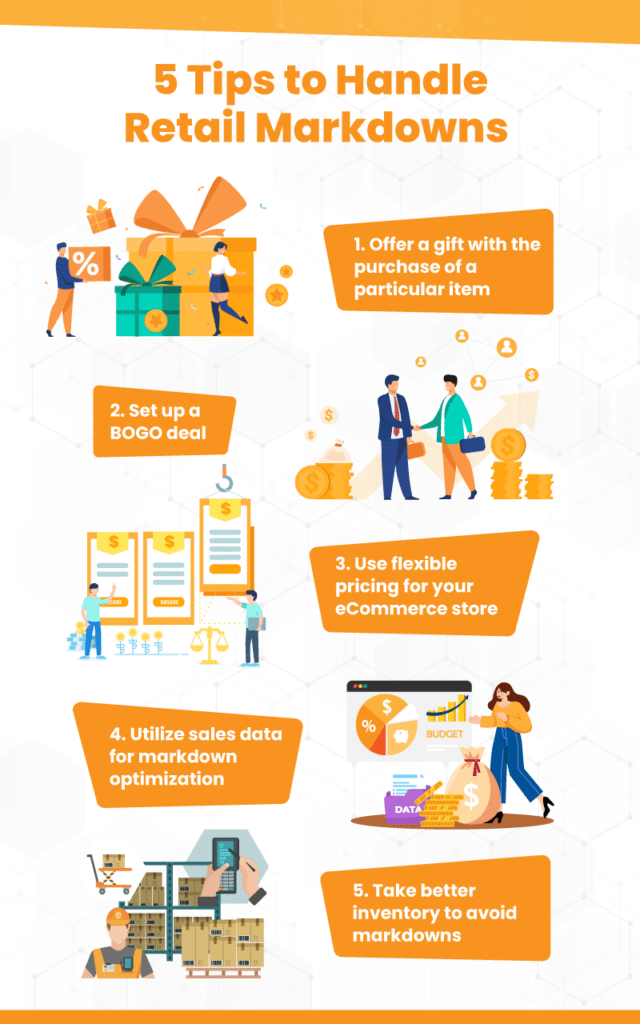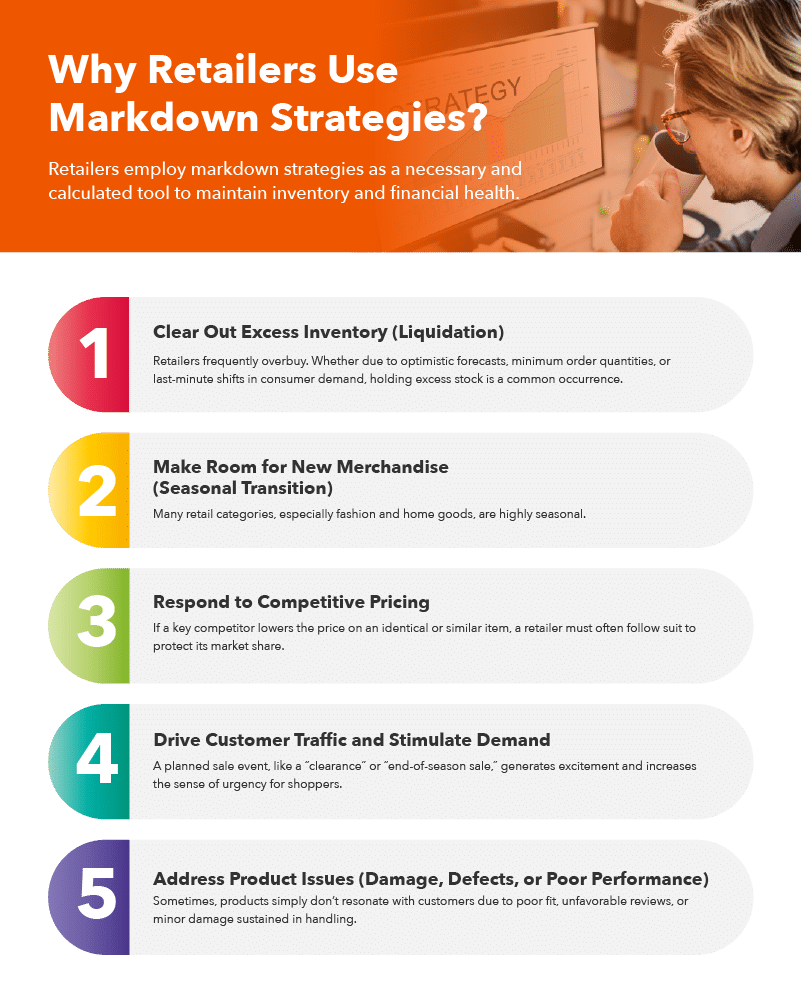Key Takeaways:
- Here are the key takeaways for retailers looking to improve their markdown strategy:
- Plan markdowns based on product lifecycle and demand trends.
- Use sales data to guide timing and discount levels.
- Apply staged or progressive markdowns to protect profit margins.
- Segment products and channels for targeted discounts.
- Track performance after markdowns to learn and improve.
- Pair markdowns with promotions or loyalty programs to boost customer engagement.
Retail markdown strategies can make or break your sales in 2025. The good news: you don’t have to guess which discounts work.
In this guide, we reveal the 8 best retail markdown strategies every retailer should know to boost revenue, clear slow-moving stock, and protect margins.
You’ll get actionable tips on timing, discount structures, customer targeting, and using data effectively. By the end, you’ll have a clear roadmap to optimize your markdowns and turn slow inventory into faster sales. Let’s dive into each strategy in detail.

What Is a Retail Markdown Strategy?
A retail markdown strategy is a planned approach to reducing product prices, boosting sales, managing inventory, and protecting profit margins. Instead of cutting prices randomly, retailers use data to decide when and how much to discount.
PRO TIP!
The goal is to move slow-selling or seasonal stock, clear space for new items, and maintain healthy cash flow. Effective markdown strategies employ gradual price reductions, track customer behavior, and strike a balance between discounts to prevent harming brand value.
When done right, markdowns improve profitability, keep inventory fresh, and help retailers stay competitive without relying on constant sales or deep price cuts.

Why Retailers Use Markdown Strategies?
Retailers employ markdown strategies as a necessary and calculated tool to maintain inventory and financial health. Price reduction is a way to manage risk and recover capital when original sales forecasts don’t materialize.
1. Clear Out Excess Inventory (Liquidation)
Retailers frequently overbuy. Whether due to optimistic forecasts, minimum order quantities, or last-minute shifts in consumer demand, holding excess stock is a common occurrence.
MUST-KNOW
Markdowns are the fastest path to turn slow-moving physical goods back into liquid cash. Eliminating the old stock frees up valuable floor and warehouse space for new, incoming products that will sell at full margin.
2. Make Room for New Merchandise (Seasonal Transition)
Many retail categories, especially fashion and home goods, are highly seasonal. Once a season ends, the value of the corresponding inventory drops sharply.
A planned markdown schedule moves out summer wear when fall collections arrive, or holiday items after Christmas.
Retailers must clear the current season’s stock to ensure the store looks fresh, relevant, and appealing to customers looking for the next trend.
3. Respond to Competitive Pricing
If a key competitor lowers the price on an identical or similar item, a retailer must often follow suit to protect its market share. Strategic markdowns help maintain price perception and keep customers from switching to a rival.
Price adjustments ensure a business remains competitive without necessarily starting a price war. The markdown is focused and targeted to products where the competitor’s actions pose the biggest threat.
4. Drive Customer Traffic and Stimulate Demand
A planned sale event, like a “clearance” or “end-of-season sale,” generates excitement and increases the sense of urgency for shoppers. You can also learn more about how to calculate your sales per square foot by using the calculator below:
Markdowns act as a powerful magnet, bringing more shoppers into the store or onto the website.
While the sale items have lower margins, the increased traffic often leads customers to purchase full-priced, high-margin items they hadn’t planned on buying (known as “attaching” or “cross-selling”).
5. Address Product Issues (Damage, Defects, or Poor Performance)
Sometimes, products simply don’t resonate with customers due to poor fit, unfavorable reviews, or minor damage sustained in handling.
A markdown provides a way to recover some cost from items that would otherwise have to be discarded or sent to liquidators for cents on the dollar.
It is a necessary financial maneuver to mitigate the loss on underperforming investments.

Free printable templates and checklists to help you manage retail operations with ease
Types of Markdown in Retail
Retail markdowns reduce prices to move inventory, with types varying by goal and duration. Here are the main ones:
- Promotional Markdowns: Short-term cuts, like 20% off during sales events, to spike volume and attract crowds without long-term harm to pricing.
- Permanent Markdowns: Price drops that stick, often on flawed or outdated items, resetting the retail value to match new market realities.
- Clearance Markdowns: Deep discounts (40-70%) on overstock or seasonal holdovers to quickly clear shelves and recover cash.
- Competitive Markdowns: Targeted reductions to counter rivals’ prices, preserving share in price-sensitive categories.
- Operational Markdowns: Quick fixes for damaged goods or pricing errors, minimizing waste on imperfect stock.
Pick types based on data—promos for peaks, clearances for laggards—to safeguard margins. (98 words)
Retail Markdown Strategy for Your Business
Implementing a structured markdown strategy moves you from reacting to unsold inventory to proactively managing your profits. Here are eight retail markdown strategies:
1. Time-Based Progressive Markdowns
This strategy schedules price reductions according to a pre-determined calendar for seasonal goods. The discount increases incrementally as the product ages.
- Rule: Start with a shallow discount early in the liquidation cycle to capture less price-sensitive customers, then deepen the cut later.
- Example:
- 30 days past peak season: 25% Off
- 45 days past peak season: 40% Off
- 60 days past peak season: 60% Off (Final Clearance)
Inventory management a headache?
Track inventory aging down to the minute. Ensure your team uses KORONA POS to generate real-time inventory reports that tell you exactly when items cross key markdown thresholds.
2. Data-Optimized Markdowns
Using predictive analytics to forecast demand and calculate the optimal price point and timing that maximizes revenue recovery.
- Key Concept: Instead of using fixed percentages, the discount is dynamically calculated based on the probability of selling the remaining units at a given price before a specific target date.
- Best For: Retailers with high volumes, short product lifecycles, and sophisticated inventory tracking.
- “The goal is the highest price that clears the stock, not the deepest discount you can afford.”
3. Localized or Tiered Markdowns
Applying different markdown depths based on store performance, regional weather, or local demand.
- Store Tiers: A store with high demand for an item may keep the full price longer, while a store with low demand marks it down aggressively.
- Regional Factors: A chain retailer might offer winter jackets at a deeper discount in warmer southern locations much earlier than in cold northern regions.
Use KORONA POS to manage pricing and markdowns across multiple locations efficiently without manual overrides.
4. Bundling and Multi-Buy Markdowns (Alternative Pricing)
Lowering the effective price by requiring the customer to purchase multiple items, thereby increasing the average transaction value and clearing more units.
- Strategy Examples:
- BOGO (Buy One, Get One) Free/Half-Price: Effective for moving large volumes of apparel or accessories.
- Kit Pricing: Bundle a slow-moving item with a popular accessory (e.g., clearance coffee maker with full-price coffee filters).
- Value: Customers perceive higher value, and you liquidate two units instead of one.
5. Category-Specific Clearance Areas
Creating a permanent, highly visible “Clearance” section both in-store and online, where all marked-down items are consolidated.
- Customer Psychology: Shoppers who visit the clearance area are expecting and actively looking for discounts. Separating these items prevents the marked-down stock from devaluing the full-price merchandise on the main floor.
- Execution: Use strong visual merchandising and clear signage, such as “Final Sale – Prices as Marked.”
6. Vendor or Partner Share Agreements
Negotiating with suppliers to share the cost of the markdown before it is executed.
- Process: If a product is underperforming, the retailer may agree to take a markdown if the vendor issues a markdown allowance (a credit or reimbursement for a portion of the reduction).
- Benefit: Reduces the loss impact on the retailer’s own margins and strengthens accountability in the purchasing process.
7. Markdown Sub-Setting (Aggressive Depth)
A rapid, deep markdown used exclusively for damaged, defective, or severely obsolete goods where the primary goal is total liquidation, not margin protection.
- Typical Depth: Discounts of 70% to 90% are common.
- Purpose: The item has essentially zero market value at full price. The sub-set markdown generates any possible cash recovery and avoids disposal costs.
8. Price Anchoring and Psychological Markdowns
Framing the price reduction to maximize the customer’s perceived value of the deal.
- Anchoring: Always display the original price next to the markdown price (“Was $99.99, Now $49.99”) to highlight the savings.
- Price Endings: Use psychological price points (e.g., ending prices in $9.99 instead of $10.00) to make the discounted price feel lower.
Common Mistakes in Markdown Strategies
Here are some of the most common mistakes retailers make with markdown strategies, along with practical insights on how to avoid them. Each point highlights a real challenge that affects sales, margins, or brand image.
Common Mistakes in Markdown Strategies
- Targeting the Wrong Products: Retailers often slash prices on items that sell steadily at full price, eroding profits from strong performers. Focus instead on true laggards using sales velocity data to pinpoint underperformers.
- Cutting Discounts Too Deep Too Soon: Large early discounts might spike short-term sales but hurt profitability and perceived product value. Start shallow, monitor uptake, and escalate only if needed—prices rarely rebound easily.
- Blanket Discounts Across Categories: Applying uniform cuts to entire lines mixes winners with losers, discounting hot items needlessly. Segment by SKU, size, or channel for precise hits—online trends differ from store foot traffic.
- Ignoring Timing and External Factors: Markdowns often fail when launched during unfavorable weather conditions or economic downturns without proper adjustments. Factor in seasons, events, and local conditions; revisit weekly to tweak.
- Sticking to Lagging Data or Manual Processes: Weekly reports catch problems late, forcing panic cuts; manual spreadsheets invite errors and delays. Shift to real-time analytics for proactive decisions that preserve profits.
- Letting Silos Block Coordinated Efforts: When buyers, merchandisers, and pricers work in isolation, they create mismatched markdowns that overlook big-picture goals, such as inventory turns.
- Over-Relying on Markdowns as a Cure-All: Treating discounts as the go-to fix masks deeper issues like poor assortment or supply glitches, while cheapening brand image. Pair with upfront pricing tests and customer feedback to build sustainable value.
- Neglecting Technology Support: Manually managing markdowns increases errors and delays. Using a POS system like KORONA POS simplifies markdown planning, automates discount schedules, and delivers performance insights.
Speak with a product specialist and learn how KORONA POS can power your business.
Use KORONA POS to Simplify Markdown Decisions
KORONA POS centralizes the complex data needed for smart pricing. Its inventory management software tracks product aging and sell-through rates.
Accessing specific reports and analytics shows you instantly which items are stalling and precisely how much stock remains, replacing guesswork with data. For multi-location businesses, you can apply localized price changes or set dual pricing rules instantly across all stores from one platform.
Furthermore, KORONA POS features a robust loyalty program that turns temporary price reductions into targeted incentives.
MUST-KNOW
Instead of broad, margin-damaging markdowns, you can apply particular discounts (even the trickiest ones) only to customer segments with expiring rewards or buying habits that warrant a specific deal. Utilizing these detailed features streamlines markdown execution and protects your profit margins better than manual processes.
Simplify markdown management and maintain profits by signing up for a demo or calling 833-200-0213 to speak with a KORONA POS specialist.
Speak with a product specialist and learn how KORONA POS can power your business.
FAQs: Retail Markdown Strategy
What is markdown in retail pricing?
Markdown in retail pricing refers to reducing a product’s original selling price to stimulate sales and move inventory. Retailers often use markdowns to manage excess stock, seasonal items, or slow-selling products. Offering discounts can attract customers and improve overall revenue while maintaining a healthy inventory turnover rate.
What is an example of a markdown in retail?
An example of markdown in retail is a clothing store applying a 30% markdown on winter coats at the end of the season to encourage customers to buy them before new stock arrives. This way, the store clears the inventory in time for the new season
How do markdowns benefit a store?
Markdowns benefit a store in several ways. They help clear out excess or slow-moving inventory, freeing up space for new merchandise.
Markdowns also attract price-conscious customers and boost sales, which can lead to increased foot traffic and brand loyalty.
Finally, strategic markdowns prevent inventory obsolescence and minimize potential losses, ensuring the store remains competitive and financially viable in the long run.












